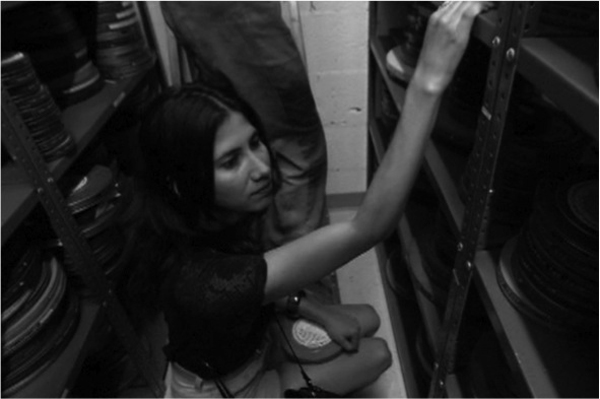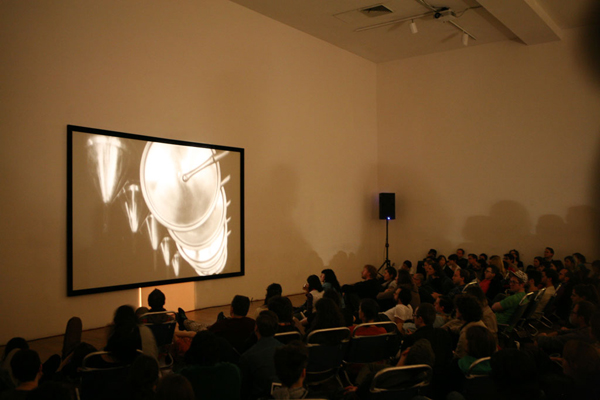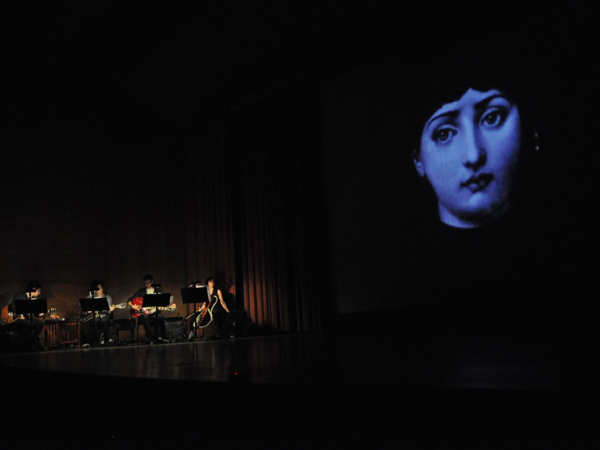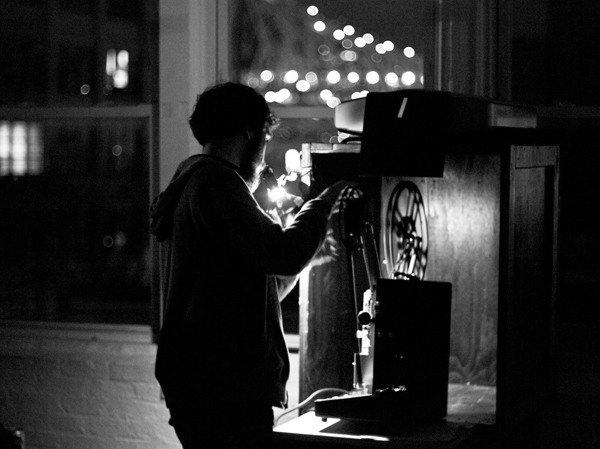Interview with Molly Surno
By Joel Schlemowitz
 Molly Surno / Photo: Shiho Kataoka
Molly Surno / Photo: Shiho Kataoka
I first met Molly Surno when she contacted me about showing one of my short films at The Bell House, down in Brooklyn’s industrial and artsy Gowanus area. A new score was to be written for it by the composer and vocalist Julianna Barwick and performed live. I recall what an intriguing experience it was to attend a screening where my own film would become a new and unfamiliar thing to me, with the addition of a soundtrack I would not hear until that evening. The attendees were not the typical film crowd I’d come to know, but an amalgam of people who were drawn to the screening for different reasons: the music, the films, because it was on The Bell House calendar, or because it just sounded like something interesting to do that night. Molly introduced the program with profuse enthusiasm, large, white letters in Copperplate font projected on the movie screen behind her: ~C/16~
With Barwick positioned off to the side, the film was shown without any of the irksome obstructions one often finds when screenings are paired with live music; no encroaching shadow of a mic stand or cymbals. I learned later there had been a great sensitivity on Molly’s part to the presentation of the film in relation to the musicians. There were even attempts at some earlier Cinema 16 events to use curtains to obscure the musicians from the audience’s view. As I had hoped, the film she selected took on a new, more ethereal and hermetic persona with Barwick’s digitally looped vocals. It was not so much that a new score had supplanted the original version, but that a novel variation of the source material came suddenly into existence in this singular instance, and then vanished again when it was over.
I was curious about the connection between Molly’s series and the original Cinema 16, the film society founded and run by Amos and Marcia Vogel in New York City from 1947 to 1963; and about her conscientious methodology for presenting these compound works of cinematic image and live music. The interview has been edited for length and clarity.
* * *
Joel Schlemowitz: We could start by talking about what sparked your Cinema 16 series into being, and its relationship to the original Cinema 16?
Molly Surno: I moved to New York at the beginning of 2006, very much looking for a community of like-minded people with whom I could share expressions of artistic, filmic, musical, and political ideas, in a way I didn’t feel like I could where I was. I think that fantasy of New York propelled a lot of people to move here.
JS: And where was it that you moved from?
MS: I’m originally from Los Angeles, which obviously has a rich film culture, including an independent film culture, and its own art world. But I did feel that the idea of community was very different there, due in part to the city’s urban planning. I felt a lot of fantasy and fetish around Warhol’s Factory and the East Village during the No-Wave scene.
One of the things I came across that I found deeply inspiring was Amos Vogel’s Film as a Subversive Art (1974). I was sort of self-taught in the language of experimental cinema, and this was one of the texts that helped educate me. Upon further research I learned about Cinema 16, which during its time was one of the largest film societies in America. Amos and his wife Marcia were so inspired after seeing a screening of Maya Deren’s films in Greenwich Village in 1947 that they decided to start a regular, membership-based screening series, which would showcase experimental films, non-narrative short films, student films, PSAs, commercials. I loved learning about that sort of collage programming, combining disparate forms to create a curated show for your community. It wasn’t a screening per se; it was more like a gathering.
Reading about the Fluxus movement and the Happenings, I really thought a lot about how people physically gather to embrace or experience art and media, which we tend to do in a more solitary, isolated, non-conversational way now. I wanted to – I used to say “resurrect” but maybe that’s not the appropriate term – I think I was essentially looking to find a culture, reinstate a conversation, and a collective. So it became more a “rendition” of the original, rather than a “resurrection.”
So that’s my relation to the original. Unfortunately I was never able to meet Amos, although we did exchange some back and forth. We were potentially going to do a show together, but unfortunately if you don’t hustle you can run out of time. [Ed. note: Amos Vogel passed away in 2012].
JS: What did he think about what you were doing?
MS: We never corresponded directly; it was all through other people, Bradley Eros being one of them. Some of the original Cinema 16 members have come to a few of our shows, though, which is really remarkable. And of course the reason I feel uncomfortable calling it a “resurrection” is that it is part of a lineage, but I’m not replicating anything; just upholding some principles and values. It’s not a carbon copy by any stretch of the imagination. It was nice when some original members came because they could see how the trajectory of the program developed its own, new identity.
 Metropolitan Museum of Art with Nik Zinner (Yeah Yeah Yeah's), Brian Chase (Yeah Yeah Yeah's), Shahin Motia (Onieda), and MV Carbon.
Metropolitan Museum of Art with Nik Zinner (Yeah Yeah Yeah's), Brian Chase (Yeah Yeah Yeah's), Shahin Motia (Onieda), and MV Carbon.
JS: Can you tell me a bit about the parameters you have for combining music and image?
MS: It took me awhile to find my sea legs with this program. It began as a one-off event. I started by pulling from a variety of short films, narrative and experimental – and later on, feature films – and pairing them with musicians who create unique scores, performed live.
The first show I ever did was at the space of Jules de Balincourt – an extraordinary painter – in Bushwick, which would host baptisms and quinceañeras, but also art shows, live nude drawing, and yoga classes. Ryan Trecartin did some performances there. De Balincourt asked if I was interested in doing something at the space, and that’s when I pitched him the idea for Cinema 16. I had work by Ladislas Starevich, a Polish entomologist who lived in Moscow. Because of his access to insects through his job at Kovno’s Natural History Museum he was really able to develop his true life’s passion, which was filmmaking. He made The Cameraman’s Revenge (1912), and all of these films using insects as puppets. So I invited a 17-piece brass band that was displaced by Hurricane Katrina to contribute music. They crafted a gorgeous, original, unique score for a one-time performance, which became an important identifying characteristic of the program.
JS: How did you connect with the musicians?
MS: Luckily my community has always been about interacting, collaborating, forming relationships with other artists – and of course that takes many forms. With respect to the Starevich event, I met one of the band’s trumpet players and started developing friendships within his circle, and eventually asked them to create and perform the score – having no idea what kind of reach the event would have. I was shocked when 400 people came to our first show! It was remarkable for me not only because the performance itself was so extraordinary; I was also impressed with the combination of the films and the new music that had been written for them. The band took the challenge so seriously. I don’t ask people to write songs, I ask that they interpret a filmic language musically. The majority of the bands I work with are not exclusively composers; they write songs, they perform those same songs, they’re awesome songs, but nonetheless it’s a very different kind of music-making. In this case I’m not looking for a chorus – or even a voice. Sounds can be fragmented, an instrument can – in the Fantasia lineage – take on a character, or not. It’s totally open to interpretation. I was so deeply touched and impressed by the depth of the band’s response to the films. I was also completely moved by how many people showed up for the event. For me it was not just a wakeup call; it helped me to understand that this was an experience that people were longing for, and that this is what my community was craving: a way to interact with art on a casual level. There’s nothing about it that’s formal or stuffy. It’s not like going to a movie theater, either, where you just kind of check in and check out; there’s a component that is festive, social, and which makes people feel like they’re part of a larger collective.
After that I started doing events with greater frequency, primarily drawing from Surrealist films in the beginning. Then I thought that in order to develop my language as a curator I couldn’t stay within these narrow confines – Man Ray, Fernand Léger, for example – I really wanted to expand my knowledge, curatorial ideas and creativity. So I did a lot of research, went to a lot of archives. As the program developed I started reaching out to bands that I didn’t know, through MySpace, or asking people who they were listening to, and just started creating pages and pages of notes of films and musicians that I liked, which I drew on to create programs.
Much like the original Cinema 16, I started pulling from a diverse body of work: materials in the public domain, animation, experimental films, primarily non-narrative but some early narrative films as well. On rare occasions I would work with more contemporary filmmakers.
I then began receiving commissions from artistic institutions, museums, galleries. Smack Mellon, a Brooklyn non-profit gallery space, became a supporter of the program and helped me tremendously. That help is greatly responsible for why the program exists today, because they were the first to bring the program into an enormous space, with an infrastructure. It wasn’t just me in a DIY space. Working with Smack Mellon really formalized the program.
You asked me what my version of Cinema 16 is? It really matured and came into its own while working with Smack Mellon. And having rules. For instance, I won’t perform in a traditional movie theater. Architecture became an important part of the program. Video art and experimental film have always been dedicated to a very specific kind of viewing experience, to the point where you almost have to be an expert in order to enjoy it. That was something I wanted to contest; I wanted to make these forms of expression more accessible. So things like pricing became very important to me. As often as I could I wanted the events to either be free or inexpensive. Sometimes I had food and drink provided through sponsorship or donation. In other words I really thought of this as a kind of a gift, directed towards a collective of people that wanted to engage in something provocative, unique, and ephemeral, which you couldn’t download. Similar to attending a ballet. You can watch a DVD of a ballet, but you won’t have the same “auratic” experience, in the words of Walter Benjamin, as you would in the presence of the physical bodies dancing before you. I feel much the same way with this program. You can watch a Vimeo clip of the documentation, but ultimately the power comes from the human presence and the energy of the room.
JS: Maybe we could talk a little bit about the fact that these are scores, rather than musicians responding extemporaneously?
MS: I enjoy multiple expressions of audio and visuals. Some of the things I see most often are bands playing with a Criterion Collection DVD projected in the background, or responding spontaneously to a Jordan Belson piece or analogous abstract imagery. I think one reason that Cinema 16 has garnered so much attention is because the bands typically craft new scores which aren’t going to be replicated – unless they breach the code of Cinema 16, which has happened and which there’s nothing I can do about – but what is also particular to this performance series is that bands are given six months to work with, to view, understand, and compose a score to a series of films that I’ve selected. It is a relationship that is established by three components – four, ultimately: myself, the musicians, the films, and, of course, the audience. I would argue the architecture as well. The kind of relationship that’s forged through the process is an intimate one, and that’s translated in the performance. This is another distinguishing feature of the program: the scores are composed with a lot of advanced notice. I provide the musicians with DVD reference copies of the chosen films; I then scour different archives and distributors to locate the corresponding prints. We perform the shows with as many film prints as possible.
I’ve worked with such a wide range of musicians, from solo performers like Sabrina Chap, an incredible piano player, and Joseph Keckler, an amazing piano player, performance artist and opera singer; to the 17-piece brass ensemble, krautrock bands, duos. The range has been very eclectic. Each program has its own identity. You’re never going to see the same thing twice.
 MoMA / PS1 with Forma
MoMA / PS1 with Forma
JS: Anything for you about seeing the films in a completely different way once the musicians have created their score?
MS: I work with the musicians extensively, so often I’m exposed to a lot of the sound beforehand. For me, because I don’t just think of it as a screening it’s not just about how I see the films interpreted; it is so much about creating a social sculpture, and bringing people together in this very collaborative environment. I work closely with people I really trust. On two occasions, the invited musicians have been so stumped by the selected films that I had to reprogram one or two. The whole experience becomes electric: the score in relationship to the films, but also to the audience, and the space being filled, especially when it’s a more unusual location. I once did a program under the Manhattan Bridge and used the bridge to project onto, so the bridge was the screen. Thinking about the stones, and the people who had built this – and we were building the score, building this community. Then there were the trains was going by, which added a new component to the score. The film was The Adventures of Prince Achmed (1926) by Lotte Reiniger. To me this was one of the most romantic nights, because it felt like everything was really activated.
JS: Maybe we can talk a little bit about the debate over whether films should be treated in some sort of holy fashion, and that adding new music could be construed as a kind of desecration?
MS: I think a lot about the concept of renditions and translations, that’s a big part of my art practice in general. As I said, Cinema 16 is not a resurrection, I’m actually translating something that existed; I’m inspired by this thing that happened before me and I’m creating something new in response. Anytime you show something in an altered format – for instance, with a DVD copy of a 16mm film – you’re translating the original intention of how that film was made. When you show Jack Smith’s work – he edited a film every time he did a performance – you are basically interpreting something that he made. Authorship and authenticity are ideas I find very provocative and interesting, and they’ve been questioned, debated, and litigated for ages. I think there are people who feel that what I do is potentially disrespecting or changing the artists’ intentions. That is one version of curating – fidelity to the original artwork and author – that I personally don’t feel particularly committed to.
I will tell you one of the main reasons: A lot of times the films are screened in places that are “holy” in relationship to the notion of the archive, with the most pristine archival prints. When we did a show at the Metropolitan Museum of Art we had 900 people at the screening, with over 1,400 people in line, for a showcase of films that certainly were not well known to the majority of the audience. In other words, making the films accessible in a very open and public way, not relegating them to the bottom of an archive. So I feel like taking the films out of the archives, out of the cinemas, is actually a way of honoring the legacy of the artists, rather than a form of disrespect. Also, I tend to believe in it as an appropriation and as derivative work – becoming its own work in-and-of itself. Because it’s done very lovingly and with respect there is a different kind of holiness. In the history of film exhibition, there’s a long, long tradition of live musical accompaniment and re-interpretation, even with films that are considered classics today, like Metropolis (1927) or Nosferatu (1922). I think that is also a component of what I do.
JS: I recall you mentioning there were some films you would not show in this fashion.
MS: Right. I’ve never shown Stan Brakhage’s work because the majority of his films do not have fixed soundtracks – that is how they were made to be seen. In the case of living artists I always work with them directly, with their permission.
Different people have different anxieties. Mine do not have to do with re-appropriating old material. My anxiety has much more to do with the isolation that is a byproduct of living in the digital era. To me, that is what’s purist about my work: bringing the physical collective body together to experience something unique. That far outweighs whether I’m removing a Bach soundtrack and adding a Soft Circle score that was crafted delicately for a particular piece on a particular evening.
JS: Bach is a good example in another way, because every so often people feel there’s a controversy about whether his keyboard works – written at a time when the harpsichord and the organ were the instruments of the day – should be played on a modern-day piano. The argument usually goes, “If Bach was alive today he would play them on a piano.” But then there are the purists who want to hear it as it sounded in its day –
MS: Yes, from an archival standpoint I feel it’s good to know how it was played, but I don’t think that should be a limitation to the immortality of his sound. Consider Hans Richter’s Ghosts Before Breakfast (1928) – its score was destroyed by the Nazis. The original soundtrack doesn’t exist; a new score was added later. When I showed that piece some people thought it was controversial, but the music I was “replacing” wasn’t even the original score. I believe in the immortality of these films more than in the purity of their sound.
JS: One thing that strikes me about the Cinema 16 events that I’ve attended is the way that it’s not a single-community audience. Sometimes when you go to film screenings you look around the room and all you see is other people from the film community.
MS: Same with art openings, you often see the same set of people. Which is nice too, because that’s also how you develop a community. But Cinema 16 is very much about blurring and blending lines: between film, art, performance, music. I really, really value that about the show, that coming together of different communities. I get very frustrated when people call a Cinema 16 event a “film screening.” I simply don’t see it in those terms.
JS: Any last thoughts about the notion of each Cinema 16 event being a one-time only experience? I imagine it would be very different if you had, for instance, a six o'clock show and an eight o'clock show.
MS: The singularity of each performance lends itself to the magic, the kind of electricity that everyone feels, like they’re participating in something unique, that everyone has a sense of ownership in. Again, so much of my anxiety arises from the idea of recreating the same experience over and over again, which then gets digitized, downloaded and dispersed. So much magic is lost in the process. To me Cinema 16 is about empowering our humanity. We’re not a gadget, we actually participate together in this human, physical way. Even the urgency to come to a Cinema 16, and the hysteria if it’s sold out, is part of the whole culture of the program – that you’re participating in a moment in history that can’t be replicated.
![]()
 Cinema 16 / Photo: John Durgee
Cinema 16 / Photo: John Durgee
Published November 6, 2014
ABOUT THE AUTHOR
Joel Schlemowitz is an experimental filmmaker based in Brooklyn, New York. He is also the editor of the film section for the East Village arts/poetry community newspaper Boog City. Screenings of his films have included the Ann Arbor Film Festival, New York Film Festival and Tribeca Film Festival. His work has received awards from the Chicago Underground Film Festival, Dallas Video Festival, and elsewhere. www.joelschlemowitz.com
